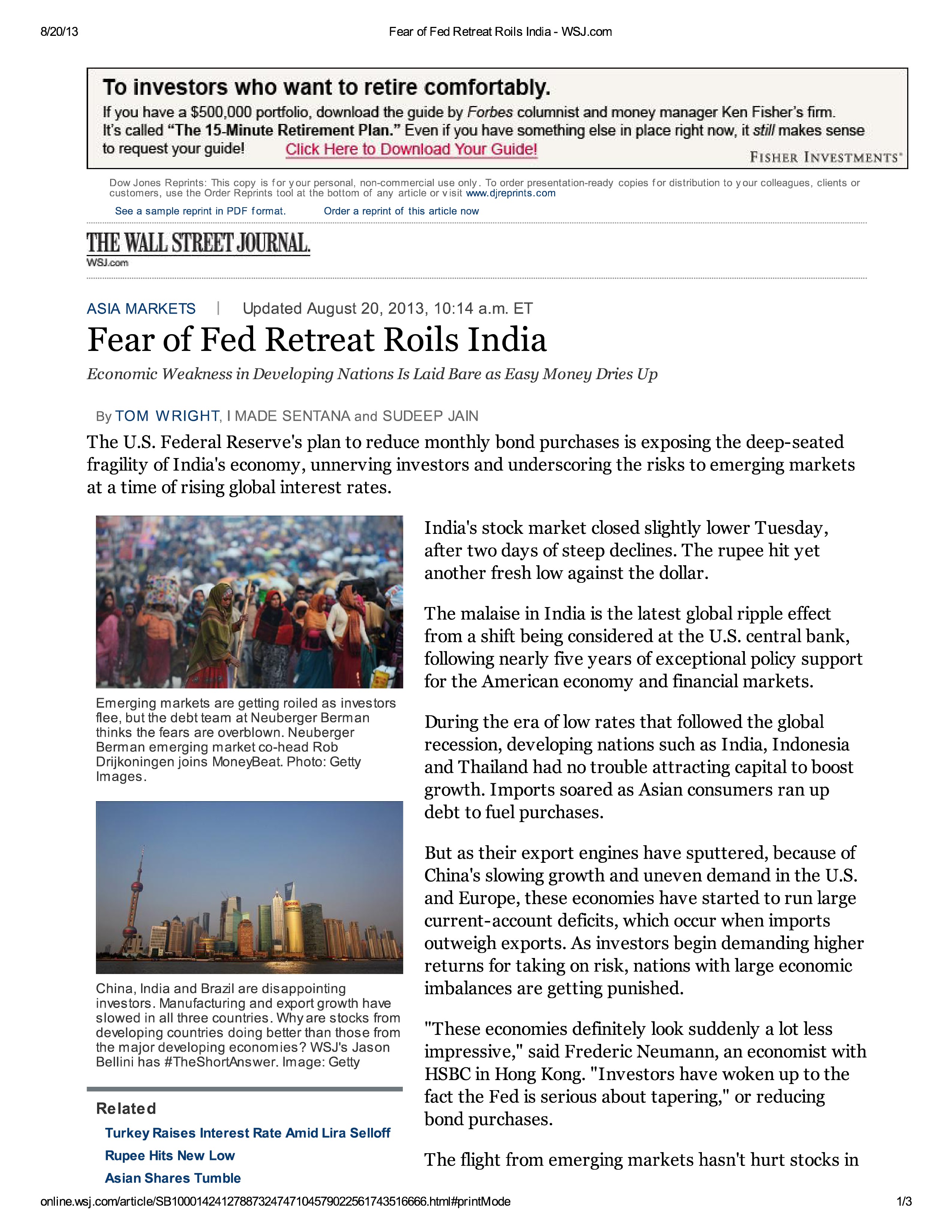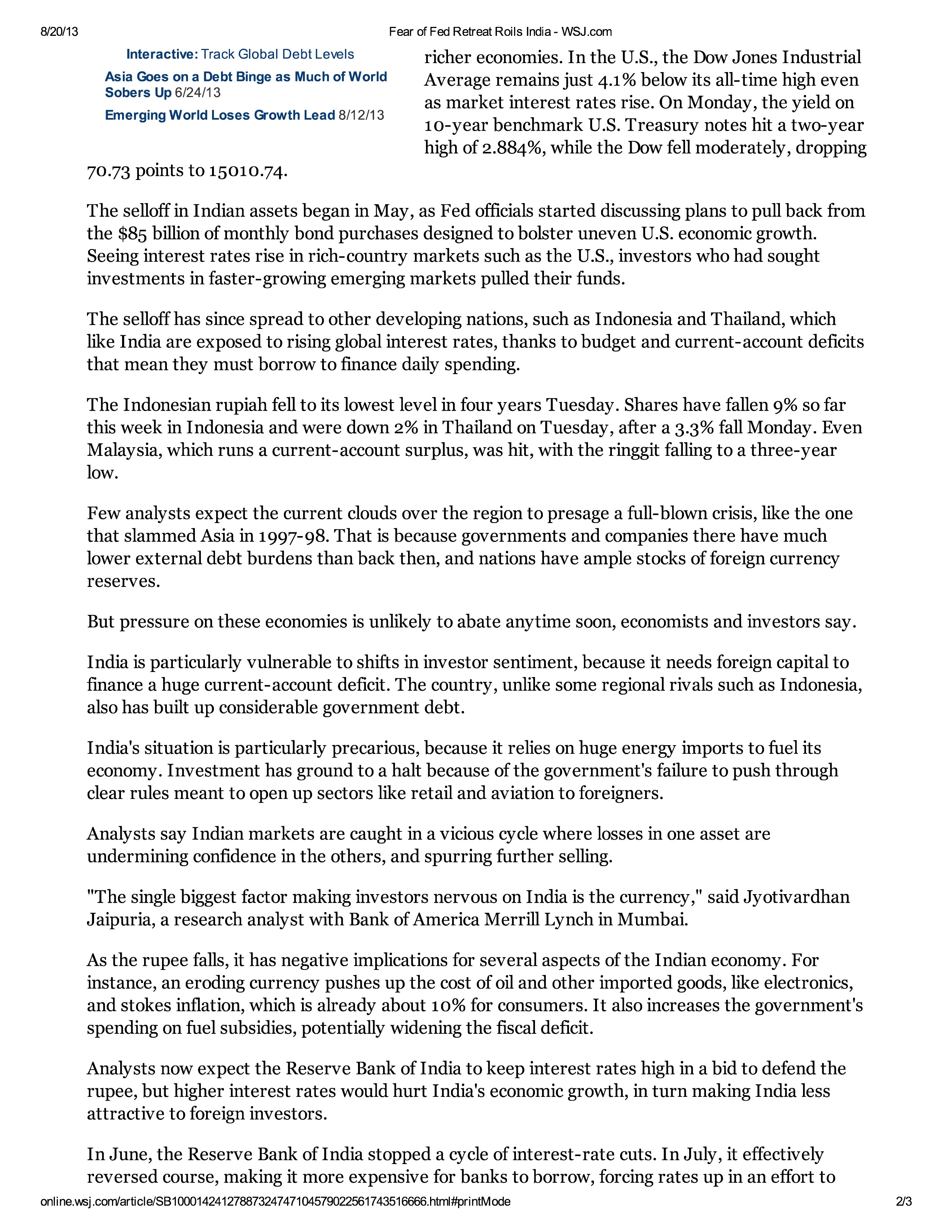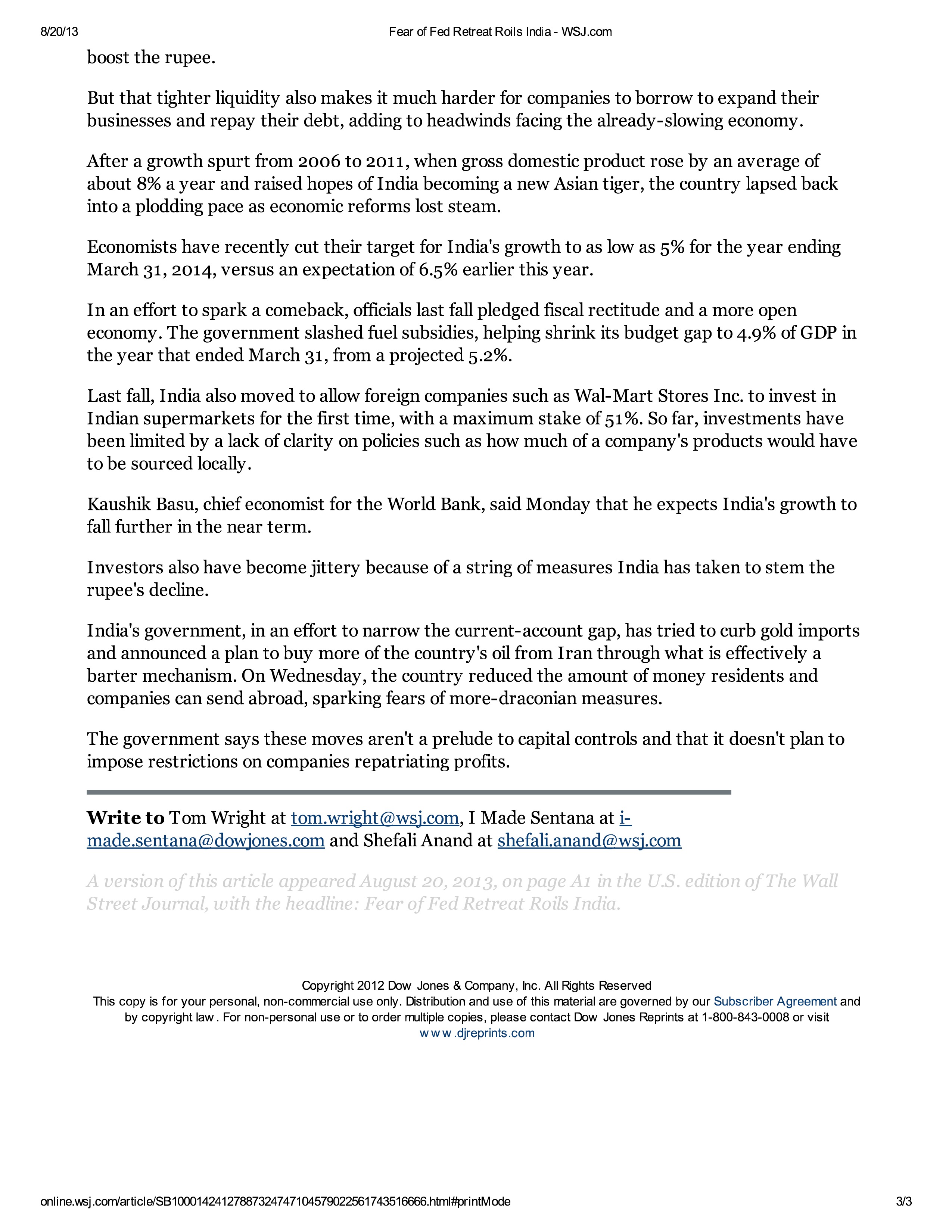Economy
August 22, 2013
The government of India has tried to blame the recent depreciation of the rupee against the US dollar on everything but the state of the Indian economy. Rupee has fallen because Indians buy too much gold, we have often been told over the last few moths.
Rupee has fallen because foreign investors have been withdrawing money in response to the decision of the Federal Reserve of United States to go slow on money printing in the time to come, is another explanation which is often offered.
While there is no denying that these factors have been responsible for the fall of the rupee, but the truth is a little more complicated than just that.
Mark Buchanan uses the term disequilibrium thinking in his new book Forecast – What Physics, Meteorology and the Natural Sciences Can Teach Us About Economics. He writes, “one of the key concepts of disequilibrium thinking is the notion of ‘metastability’ which explains how a system can seem stable, yet actually be highly unstable, much like the sulfrous coating on a match, ready to explode if it receives the right kind of spark. Inherently unstable and dangerous situations can persist untroubled for very long periods, yet also guarantee eventual disaster.”
The situation in India was precisely like that. The rupee was more or less stable against the dollar between November 2012 and end of May 2013. It moved in the range of Rs 53.5-Rs 55.5 to a dollar. This stability in no way meant that all was well with the Indian economy.
In a discussion yesterday on NDTV, Ruchir Sharma, Head of Emerging Markets Equity and Global Macro at Morgan Stanley Investment Management, provided a lot of data to show just that. In 2007, the current account deficit of India stood at $8 billion. In technical terms, the current account deficit is the difference between total value of imports and the sum of the total value of its exports and net foreign remittances.
The foreign exchange reserves of India in 2007 stood at $300 billion. So the foreign exchange reserves were 37.5 times the current account deficit. For 2013, the current account deficit is at $90 billion whereas the foreign exchange reserves are down to around $275 billion. So the foreign exchange reserves are now just three times the size of the current account deficit, in comparison to 37.5 times earlier.
Another worrying point is the import cover (foreign exchange reserves/monthly imports). It currently stands at 5.5 months, the lowest in 15 years. This is very low in comparison to other emerging markets (like China has 18 months of import cover, Brazil has 11 months).
Now what does this mean in simple English? It means that the demand for dollars has gone up much faster than their supply. And this did not happen overnight. It did not happen towards the end of May, when the rupee rapidly started losing value against the dollar. The situation has deteriorated over the last five to six years, while the government was busy doing other things.
Sharma gave out some other numbers as well. In 2007,the short term debt (or debt that needs to be repaid during the course of the year) stood at $80 billion. Currently it stands at around $170 billion. As and when this debt matures, it will have to repaid (unless its rolled over) and that would mean more demand for dollars and a greater pressure on the rupee. Given this, its not surprising that analysts are now predicting that the rupee soon touch 70 to a dollar.
What remains to be seen is whether companies which need to repay this debt are allowed to roll it over. The situation is very tricky given that 25% of Indian companies do not have sufficient cash flow to repay interest on their loans. The amount of loans to be repaid by top 10 Indian corporates has gone up from Rs 1000 billion in 2007 to Rs 6000 billion in 2013. This makes the Indian economy very vulnerable.
Politicians like to compare the current situation to 1991 and tell us that the current situation is not a repeat of 1991. In 1991, the import cover was down to less than a month. Currently it is around 5-6 months (depending on whose calculation you refer to). Hence, the situation is not as bad as 1991.
But the import cover is just one parameter that one can look at. The current account deficit in 1991, stood at 2.5% of the gross domestic product. Currently its around 4.8% of the GDP. Hence, the situation is much worse on this front than in 1991.
The government has tried to control the fall of the rupee against the dollar by making it difficult for Indian companies as well as individuals to take dollars abroad. But that was already happening. The amount of money Indian corporates invested abroad in 2008, stood at $21 billion. It has since come down to $7 billion. The amount of money taken abroad by individuals through legal channels remains minuscule.
The point is that the Indian economy has been extremely vulnerable for sometime, “much like the sulfrous coating on a match, ready to explode if it receives the right kind of spark.” It is just that where the spark will come from leading to explosion of the match, is hard to predict in advance.
As Buchnan puts it “the disequilibrium view….explains in simple terms why the moment of collapse is hard to predict: the arrival of the key triggering event is typically a matter of chance.” And this matter of chance in the Indian context came when Ben Bernanke, the Chairman of the Federal Reserve of United States, the American Central Bank, addressed the Joint Economic Committee of the American Congress ,on May 23, 2013.
As he said “if we see continued improvement and we have confidence that that is going to be sustained, then we could in – in the next few meetings – we could take a step down in our pace of purchases.”
Over the last few years, the Federal Reserve has been pumping money into the American financial system by printing money and using it to buy bonds. This ensures that there is no shortage of money in the system, which in turn ensures low interest rates. The hope is that at lower interest rates people will borrow and spend more, and this in turn will revive economic growth.
After nearly 5 years, some sort of economic growth has started to comeback in the United States. And given this, the expectation is that the Federal Reserve will start going slow on money printing in the months to come. This has pushed interest rates up in the United States making it more interesting for big international investors to invest their money in the United States than India.
This has led to them withdrawing money from India. Since the end of May nearly $10 billion of foreign money has been withdrawn from the Indian bond market. When these bonds are sold, foreign investors get paid in rupees. They need to convert these rupees into dollars, in order to repatriate their money abroad. This puts pressure on the rupee.
And this is how the decision of the Federal Reserve to go slow on money printing in the days to come has led to the fall of the rupee. This is the story that the government officials and ministers have been trying to sell to us. But the point to remember is that the decision of the Federal Reserve of United States to go slow on money printing was just the ‘spark’ that was needed to explode the ‘sulfrous coating on the match’ that the Indian economy had become. The spark could have come from somewhere else and the ‘sulfrous coating on the match’ would have still exploded leading to a crash of the rupee. Also, it is important to remember that foreign investors have not abandoned India lock, stock and barrel. When it comes to the bond market they have pulled out money to the tune of $10 billion. But they are still largely invested in the equity market. Since late May around $2 billion has been pulled out of the Indian equity market by the foreign investors. This when they have more than $200 billion invested in it.
Ruchir Sharma’s panelist in the NDTV discussion referred to earlier was Arun Shourie. He called the current rupee crisis a swadeshi crisis. It is time that the government realised this as well because the first step in solving any problem is recognising that it exists.
source: Mr. Vivek Kaul
Fear of Fed Retreat Roils India
2 Comments on “Economy” Post your comment











Tonnes of Indian currency is lying idle in hidden places of so called rich peoples which are not coming in market because of threat of taxes, corruption in every field is the root cause of depreciation of one’s currency in international market, remedy for this situation is to change the mindset of fellow Indians. It has been proved that gold is useless metal in any form of industrial use, though we are
running behind the metal . as social reforms has been taken place during the freedom fighting movements of India, the social reformers come forward without waiting for formal invitation of govt. agencies & rendered their services for preaching the peoples about good & bad at the verge of changed time & economy.
Hold it!